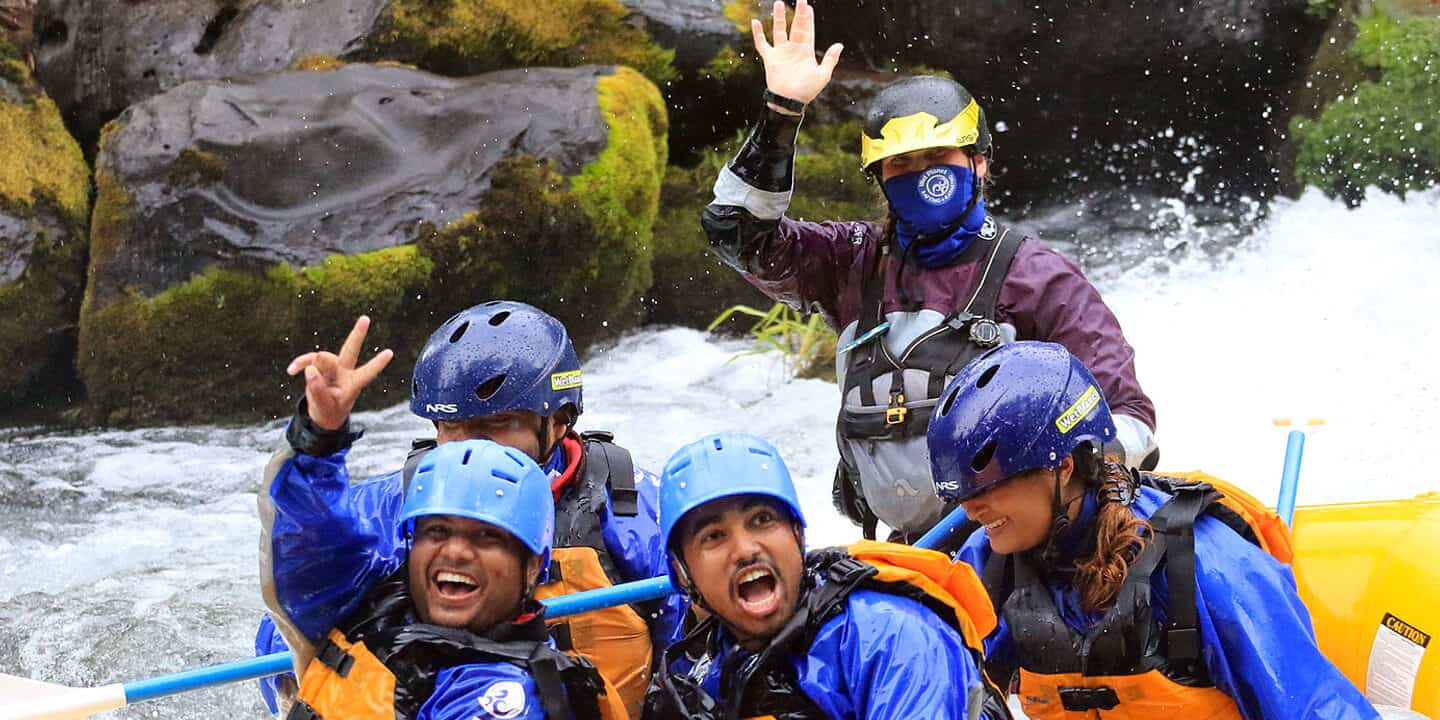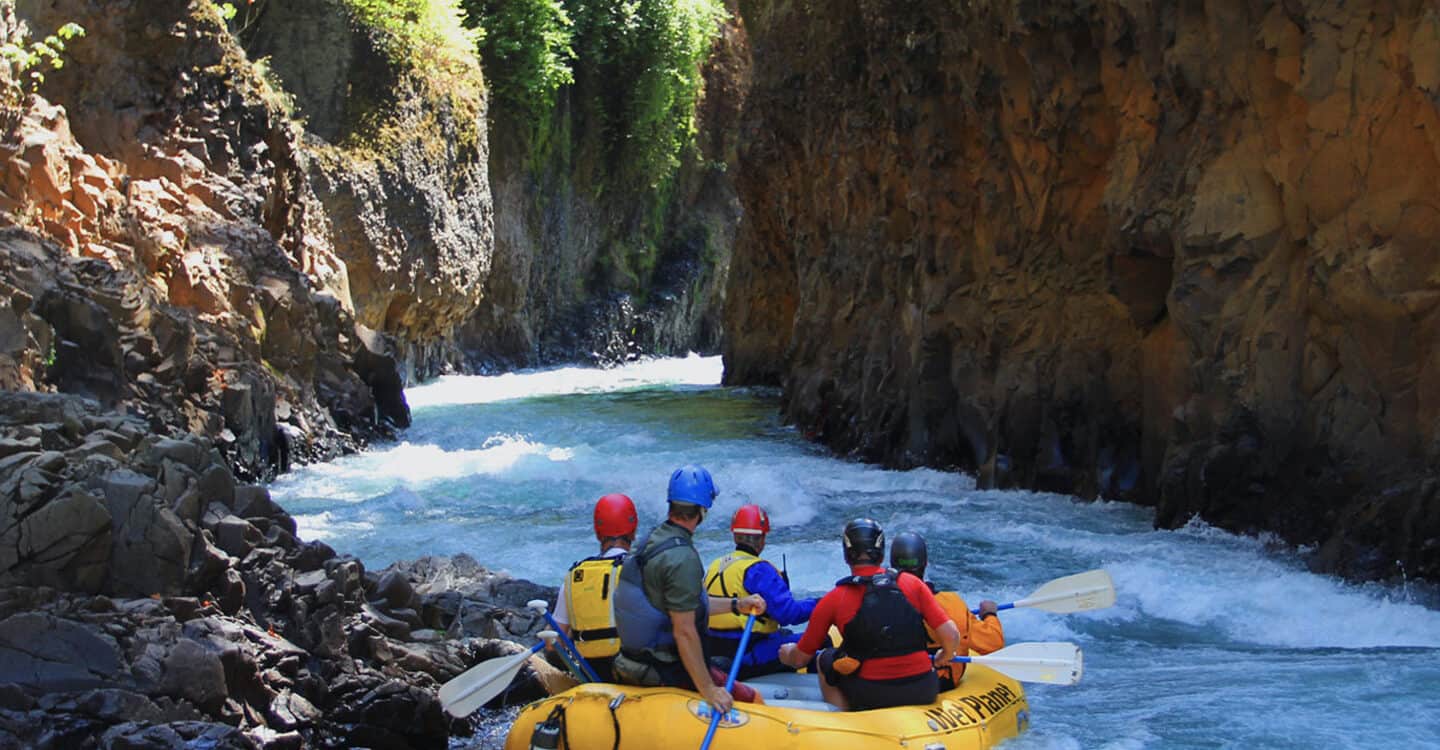After working as a raft guide and kayak instructor for more than two decades, everything I knew about how to run trips changed overnight with the introduction of COVID-19 rafting procedures.
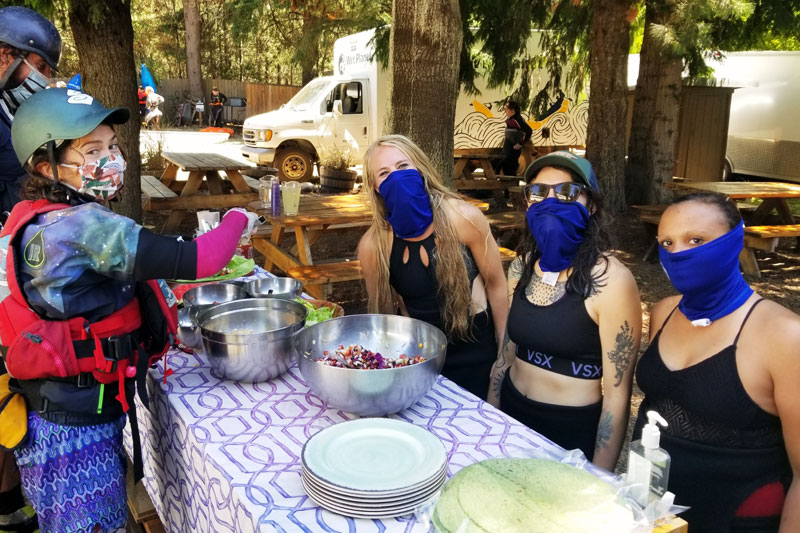
Hannah prepares to serve lunch on a Full-Day White Salmon River trip. Face masks for everyone.
When Wet Planet was finally able to open in June for the 2020 season, we were operating under a detailed COVID-19 mitigation plan. Our 20 page operating plan detailed the measures we would take in every aspect of our operation to minimize the spread of the virus among our staff and guests. We had to rethink and reorganize everything, from the procedures for outfitting guests with wetsuits and PFD’s to the way we sat in the buses. Our trip sizes were kept below 30% of our typical capacity, and family units were separated between rafts. However, as a raft guide, managing risks while adapting to changing environments is what we do. We created our COVID operating plan, implemented the changes, and got about the business of having fun on the water.
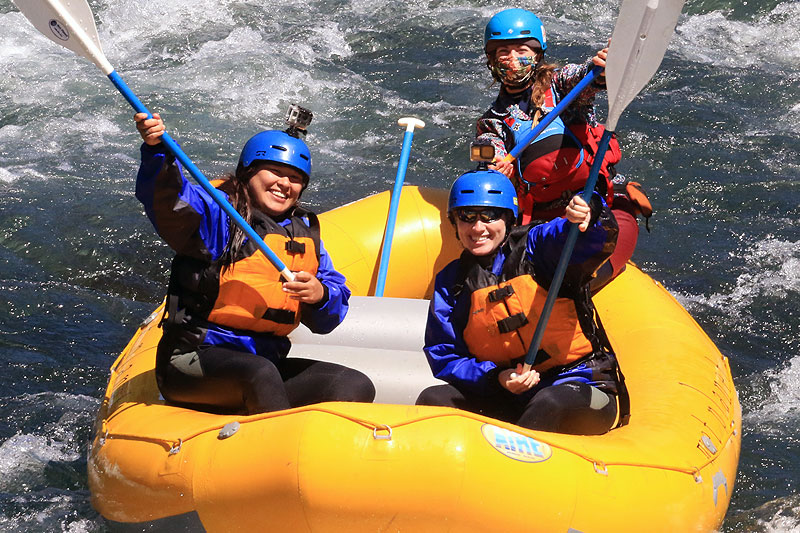
Nicky and crew having fun on a Half-Day White Salmon River trip. Outside and socially distanced, river trips were the perfect escape this summer.
While the operating plan contains lots of details, the big changes from my raft guide perspective fell under a few general categories:
- Making sure we don’t work with symptoms – health screens and COVID tests
- Facial coverings
- Cleaning, cleaning, cleaning
- Social distancing
Making sure we don’t work with symptoms – health screens and COVID tests
In previous years, the first thing I would do when I showed up for work was to stop at the Wet Planet espresso bar and get a coffee. Thanks to COVID, the espresso bar was closed this season. Instead, my first stop at work was the health screening station. In 2020, every employee started their day with a temperature check and a series of questions verifying that we were not experiencing any COVID symptoms. The checker kept logs of every employee’s daily health check. It wasn’t a big deal, and I’ll be able to repeat the questions verbatim 20 years from now. However, it was a good reminder every day that COVID was a part of our lives and something we needed to be mindful of as we moved through our day.
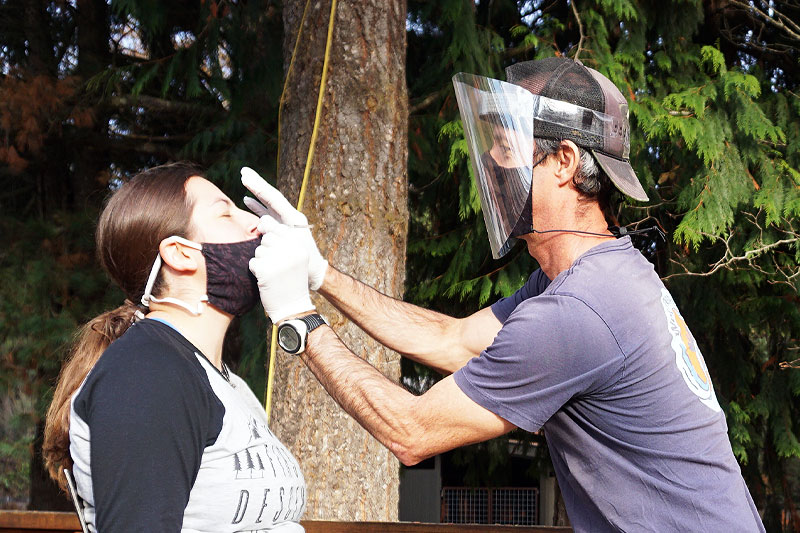
I may not be a nurse, but I play one at work. The ability to administer a COVID-19 test was a useful skill for a raft guide in 2020.
The bigger deal was COVID testing. Wet Planet took the impressive step of proactively COVID testing the entire Wet Planet staff periodically during the season, as well as testing the multi-day trip guides before they left for their multi-day rafting and kayaking trips in Idaho.
It is hard to explain what a big impact this had on our feeling of safety at work this season. Prior to the first round of COVID testing, all of us regularly guiding rafts were feeling very uncertain about whether or not we would all end up getting sick. Interacting with the public, in close contact, was pretty scary as we started to come out of our lockdowns. We had procedures in place to mitigate the risk, and we had trust in Wet Planet’s plan, but no one really knew for sure if they would work.
When the first all-staff test was announced, the entire team needed to be at Wet Planet at a scheduled time for the tests. Organizing raft guides is typically like herding feral cats. In the history of Wet Planet, there has never been an all-team meeting where everyone was present. Someone is always on a paddling trip somewhere, out of the country, or even on Wet Planet trips in a different state. For our COVID testing dates, 100% of the team showed up. We were clearly all nervous, for ourselves, our families, and our friends. We wanted to know for certain that we weren’t asymptomatic and possibly exposing our families. When the test results came back negative, there was a huge sense of relief. The plan was working. When the multi-day crew tests came back negative, and our second round of all-team testing came back negative, it had a huge impact on our confidence in our ability to come to work and stay healthy.
Now, don’t get me wrong, getting a giant swab shoved up your nose halfway to your brain is no fun. It burns! But it was all part of raft guiding in 2020. As a team we could bond over discussions about whose nostrils were bigger, and it felt good to know that I wasn’t carrying COVID.
Facial Coverings – Face Masks
Face masks were required for Wet Planet employees anytime we were inside, or anytime we were outside and unable to maintain 6 feet separation from anyone else. As a raft guide, that basically meant all of the time, since we’re continually moving around and interacting closely with people. I pretty much wore a face mask all day long, all season. Wearing a mask was awkward at first, but we got used to them quickly. Now, it’s just another piece of gear. If you ask a raft guide about face masks, you can get a detailed exposition on the pros and cons of the various mask styles: traditional mask, buff, bandana style, metal nose bridge or not, etc.
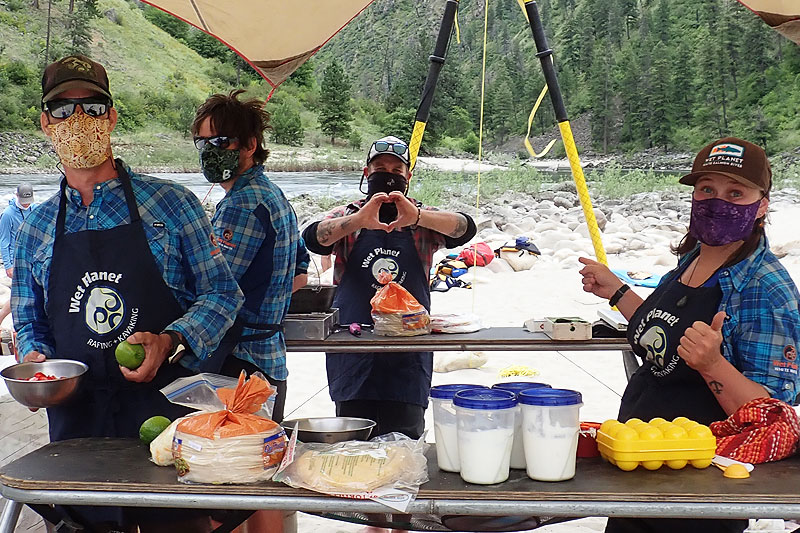
Getting ready to prepare dinner on a Main Salmon River trip, the team models the latest in river wear fashion: pearl-snap guide shirt by NRS, shades by Smith, Wet Planet apron, custom Wet Planet hats by Recaps, and custom masks by Northwave Sales.
By the end of the season, I had my mask preferences and system pretty well figured out. My daily driver, so to speak, was a custom mask by Northwave Sails in Hood River (bungee tethers that go around the head and neck with plastic toggles for adjustments, articulated cut for nose and chin, no metal nose bridge). On the river while guiding, I wore a Wet Planet COVID bandana over my face, with my mask around my neck and under my dry top, as a backup. When my bandana was too wet to function, I could reach inside my dry top and pull out my mask. I carried a spare mask in my personal dry bag, and we had an N-95 mask in the trip first-aid kit in case we needed to be in close contact with someone while performing medical care.
Wearing a mask while guiding did pose some challenges. It is not possible to breathe through a wet mask (the reason guests don’t wear masks in the raft), so we had to constantly manage our mask wearing in the raft, pulling masks down in harder rapids or when they got splashed. Trying to call paddle commands through a mask was difficult, and many of us lost our voices at times while guiding this season. However, the most challenging aspect was simply communicating without facial expressions. I spent part of a 6-day Main Salmon River rafting trip in Idaho with a smiley face drawn in the palm of my hand so I could hold it up in place of a real smile. Like every part of the 2020 season, we adapted and eventually figured out how to communicate with a piece of fabric covering our faces.
Wet Planet guide Hannah Tay, showcases her ability to communicate with her eyes while wearing a facemask.
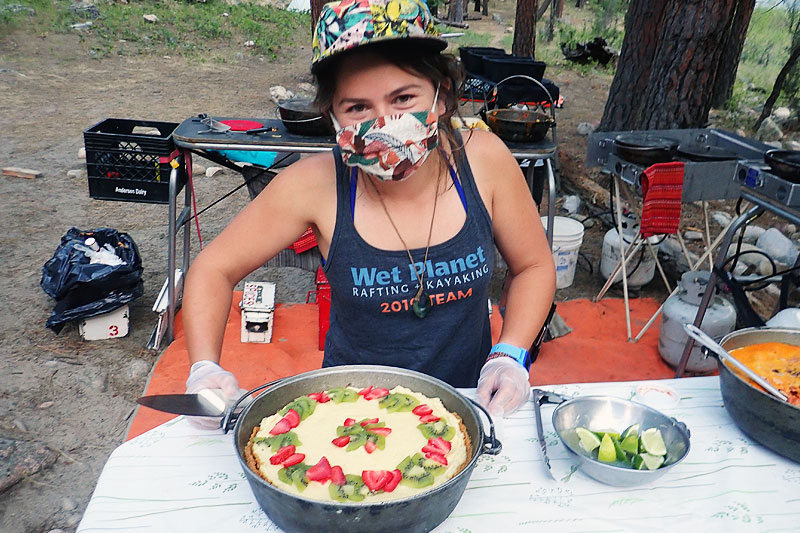
After making an incredible cheesecake, Hannah’s eyes say it all – “I just killed it with this dessert!”
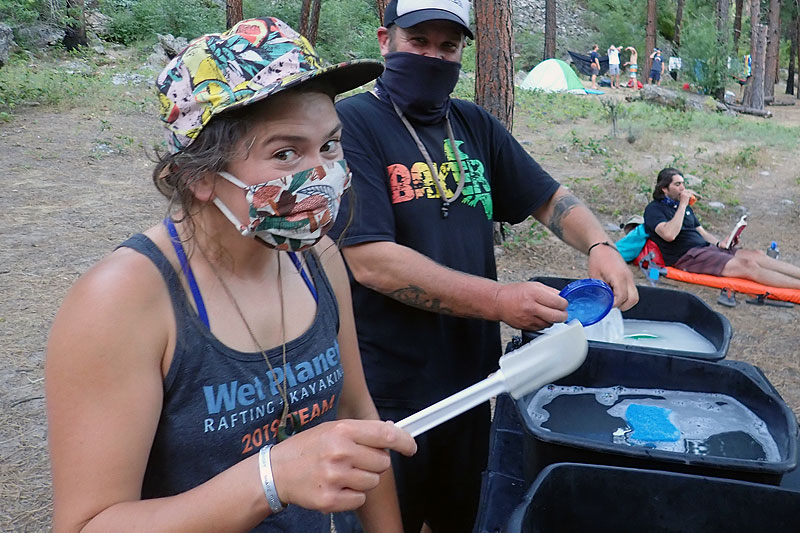
While working on dishes after a Main Salmon River trip dinner, Hannah let’s her eyes do the talking.
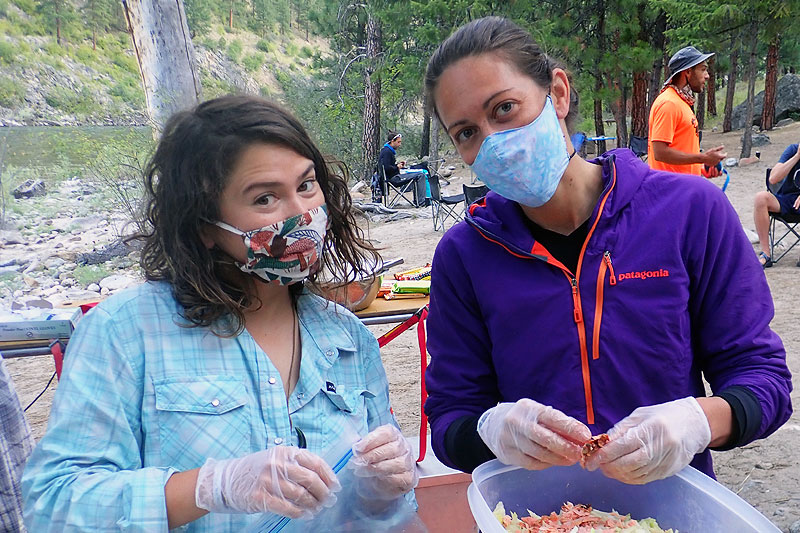
Friends on and off the river, guides Hannah and Nicole can read each others’ “facial” expressions, even with their masks on.
Cleaning, cleaning, cleaning
Our COVID operating procedures required us to disinfect everything after it was used or after every trip, and all high traffic areas throughout our base were disinfected every two hours. In addition to our normal gear washing procedures, we also set aside any personal gear that guests used (wetsuits, booties, pfd’s, etc) for multiple days before it would get reused. At first, the extra disinfecting procedures and gear management procedures were super inefficient. We needed to adjust all of our trip procedures to accommodate the extra cleaning and disinfecting steps, and we had to rebuild our wetsuit washing and drying areas.
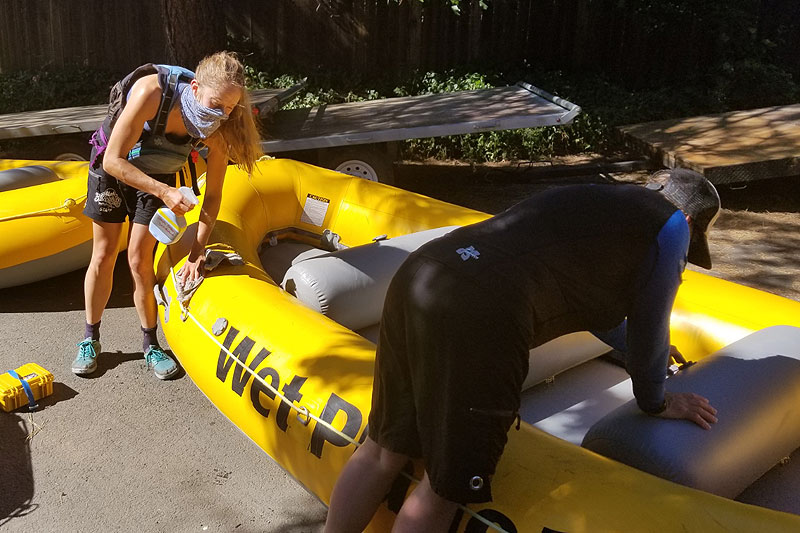
Just another day at the office. Amanda and Deanna clean and disinfect a raft after their trip.
In the end, the cleaning procedures became just another efficient part of the process. We had bulk hand sanitizer stations (sourced from a distillery in Hood River) all over the property, wetsuits were organized by days of the week, “disinfected” signs were placed in vehicles after cleaning so we didn’t accidentally double up on cleanings, daily checklists tracked our cleaning efforts throughout the day, a spray bottle of disinfectant was never far away no matter what you were doing , and we had battery powered backpack sprayers for bigger disinfecting tasks. It all became such a normal part of the day that I’ll probably continue carrying a personal hand sanitizer bottle in my PFD pocket well after the COVID pandemic has passed.
Social Distancing
The changes needed for social distancing were by far the most difficult parts of the 2020 season for me. Not only does social distancing mean you need to stay 6 feet away from people whenever possible, but it also means doing everything you can to avoid touching other people. This went against all of my instincts as a raft guide. It meant that you couldn’t shake someone’s hand when you met them and couldn’t give multi-day trip guests a hug after spending 6 days on the river with them. If someone stumbled on the portage trail, I couldn’t quickly lend them a hand. Instead, I would have to stand 6 feet away and just ask them if they were ok. If a guest fell out of the raft, I would pull them back in and make sure they were OK … then disinfect my hands. Awkward.
The positive side of the social distancing protocols was that every raft trip felt like a private trip. With small trip sizes, and family groups having their own raft, all of our White Salmon raft trips really were almost private trips. In many ways, this made for a very enjoyable 2020 rafting season. In the middle of the pandemic, where families’ options for doing fun activities together were limited, we were able to provide small-group socially distanced adventures in the outdoors. Guests were very appreciative of their trips. I always enjoy taking people out on the river and showing them an incredible experience. This season, it just felt even more special.
I took all possible efforts to stay healthy throughout the season. I wore my mask all the time, took social distancing seriously even when I wasn’t at work, and used gallons of disinfectant. I owed it to my coworkers and every group of guests I would interact with to do everything I could to keep myself healthy on every trip. However, the social distancing and lack of human connection was difficult. COVID broke many of the small human moments of connection that we have always used to support and care for each other. That’s a part of the 2020 season I’m sure we’ll all be happy to be done with.
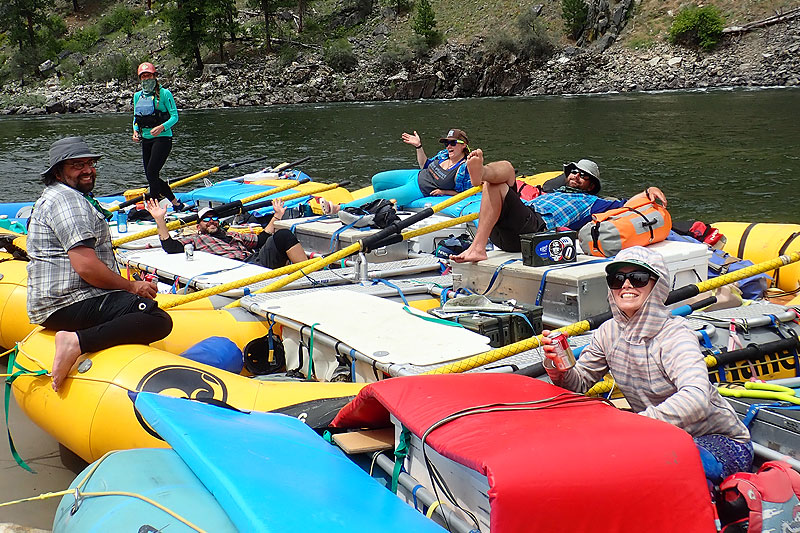
After another great day on the river, the work is done, and it’s time to relax. We’re all six feet apart. No one is moving around. We can finally take our masks off!
Author Todd Collins lives on the White Salmon River in BZ Corner and works year round for Wet Planet. You can find him wearing his mask and sharing his passion for whitewater while guiding rafting trips, teaching kayak courses, and instructing river rescue courses at Wet Planet.

